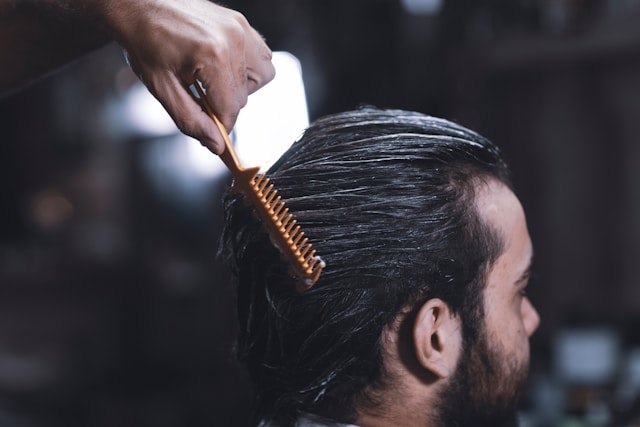
Millions of individuals worldwide suffer from hair loss, a prevalent condition that often causes mental pain and low self-esteem. Although a number of reasons, including genetics, hormone fluctuations, medical issues, and lifestyle choices, may contribute to hair loss, there are a number of useful solutions available to address this issue. You can control and even reverse hair loss by investigating a variety of therapies, from cutting-edge medical procedures to all-natural cures. This guide delves into some of the most effective methods to combat hair loss, offering valuable insights and practical advice for those seeking to maintain or restore their hair health.
Nutritional Interventions for Hair Health
A balanced diet can help prevent hair loss and is essential for keeping hair in good condition. Hair development and strength are supported by vital nutrients, including zinc, iron, and selenium, as well as vitamins A, C, D, E, and B complex. Since protein is the foundation of hair, it is also essential for hair regeneration. You can get the protein you need by eating lean meats, fish, eggs, beans, and nuts. Walnuts, flaxseed, and salmon are excellent sources of omega-3 fatty acids, which support and nourish hair follicles and encourage hair development. Furthermore, maintaining optimum function and health of hair cells is ensured by consuming enough water to keep hydrated.
Topical Treatments and Medications
Numerous topical therapies and pharmaceuticals are available that have been scientifically shown to assist in both promoting hair growth and lessening hair loss. A common over-the-counter drug that is known to lengthen the hair growth phase and increase follicle size is minoxidil. Applied directly to the scalp, it is effective for both men and women. Men’s prescription medication, finasteride, prevents hair loss by inhibiting the hormone that causes it. When taken orally, it can greatly reduce hair loss and encourage new growth. Additional topical therapies, such as ketoconazole shampoos, can treat diseases like dandruff that can aggravate the scalp and cause hair loss.
Laser Therapy for Hair Regrowth
A cutting-edge, non-invasive procedure called low-level laser therapy (LLLT) stimulates hair follicles to encourage the creation of new hair. Through the use of red light lasers, the scalp is penetrated in order to promote the growth phase of hair follicles and increase blood flow. LLLT can be used at home with laser combs and helmets, or it can be given in a clinical environment. Research indicates that regular use of LLLT can help people with androgenetic alopecia and other types of hair loss achieve fuller, thicker hair. As this therapy is usually well-tolerated and safe, it appeals to those looking for non-surgical hair loss treatments.
Hair Transplant Surgery
A permanent treatment is provided through hair transplant surgery for those with substantial hair loss. In this treatment, hair follicles from a donor area—usually the back of the scalp—are extracted and then implanted into the balding or thinning portions of the scalp. Folic unit transplantation (FUT) and follicular unit extraction (FUE) are the two primary methods. FUE takes individual follicles straight from the scalp, while FUT removes a strip of the scalp and divides it into individual follicular units. Both techniques are quite successful and provide results that seem natural. Even though hair transplant surgery is more intrusive and has a longer recovery period than other treatments, it is an excellent option for restoring hair density and getting long-lasting results.
Scalp Micropigmentation for Immediate Results
By applying small pigment deposits to the scalp, a non-surgical cosmetic process known as scalp micropigmentation (SMP) gives the illusion of thicker hair. Those who like to give the appearance of having a precisely shaven head or who have bald spots or thinning hair may find this approach very helpful. A realistic and natural appearance is achieved by matching the pigments to the natural color of the hair. SMP can also be used to camouflage scars from previous hair transplant surgeries or injuries. The process yields rapid results and is comparatively fast with little downtime. Scalp micropigmentation in Los Angeles is a great option for people seeking an efficient and quick cure for hair loss.
Lifestyle Changes to Support Hair Health
Healthy lifestyle choices can have a big influence on the health of your hair and help stop more hair loss. Stress reduction techniques like yoga, meditation, and consistent exercise can enhance general health and have a favorable impact on hair development. Hair follicle damage can be avoided by avoiding severe hair treatments such as chemical treatments, tight haircuts, and extensive heat styling. Hair integrity can be preserved by gentle hair care techniques, including sparingly brushing and using light shampoos and conditioners. Additionally, quitting smoking and limiting alcohol consumption can improve circulation and nutrient delivery to the hair follicles.
Conclusion
Combating hair loss requires a multifaceted approach that includes nutritional support, medical treatments, advanced therapies, and healthy lifestyle practices. You can choose the best course of action to deal with hair loss and encourage hair regeneration by investigating and combining various techniques. Whether opting for natural interventions, topical treatments, laser therapy, hair transplant surgery, scalp micropigmentation, or lifestyle changes, each method offers unique benefits to help you achieve healthier, fuller hair.


